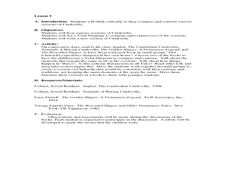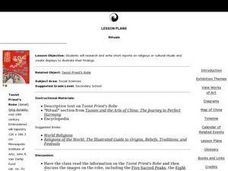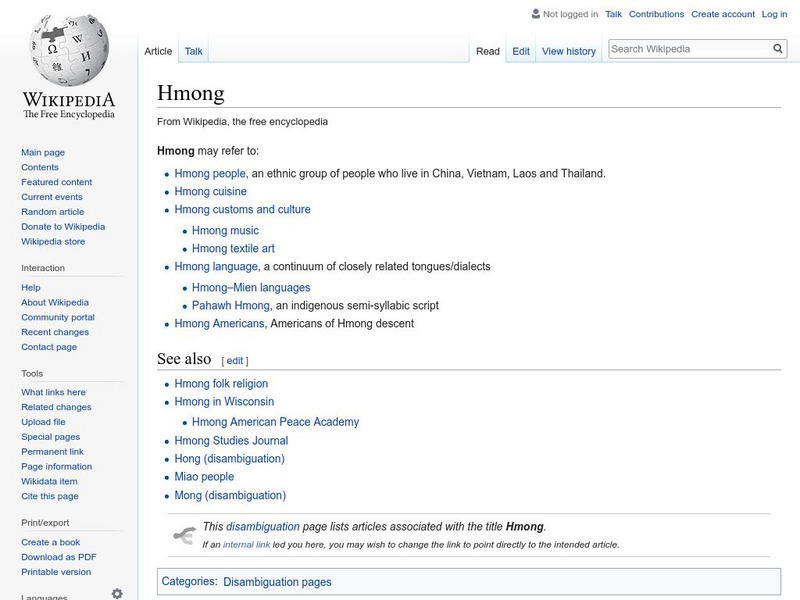Curated OER
Word Play
Students examine the Japanese folktale, Monkeys Grasp for the Moon. In this multicultural literature lesson, students discuss the theme of the folktale. Students choose animal folktales from other Asian cultures for comparison.
Curated OER
Word Play
Middle schoolers explore the work of Xu Bing. In this visual arts lesson, students examine the art piece "Monkeys Grasp for the Moon" and compare it to the Buddhist folktale on which it is based. Middle schoolers create animated flip...
Curated OER
Pearl S. Buck: "On Discovering America"
Students describe myths and realities of immigration. In this "On Discovering America" lesson plan, students compare and contrast the American view of immigrants in the 1930s and how the media portrayed immigrants in the 1930s using...
Curated OER
Southeast Asian Folktales
Fifth graders locate and identify the countries of Southeast Asia on a map. In groups, they compare and contrast photographs and artifacts from their own lives with those living in Asia. They write their own folktales based off of...
Curated OER
The Clothing of the Buddha
Young scholars discuss the idea of cultural diffusion by examining how the sculptural portrayal of the Buddha's clothing evolved in Japanese and Chinese art. This lesson concludes with a group project and presentation.
Curated OER
The Medium And The Message
Students compare and contrast Buddhist sculpture in varying materials through in-class discussions and small cooperative learning groups. This lesson includes possible lesson extensions.
Curated OER
Rethinking Time, Age, And the Calendar
Students creat personal timelines, marking key events in their lives. They discuss the different events with a small group. They analyze how Western Civilization influenced their timeline in comparison to Eastern Asia.
Curated OER
Rituals
Students research and write short reports on religious or cultural rituals and create displays to illustrate their findings.
University of Washington
University of Washington: China's Geographic Endowment [Pdf]
This unit provides basic background on China's geographic endowment and raises the issue of Chinese ethnicity and the presence of minority groups in China.
Curated OER
Etc: Maps Etc: Ethnolinguistic Groups of China, 1971
" Ethnolinguistic Groups - Almost all inhabitants of mainland China are of Mongoloid stock, and ethnic distinctions in the country are largely linguistic rather than racial. The Han comprise nearly 95 percent of the population; the...
Countries and Their Cultures
Countries and Their Cultures: Ainu
Learn why there is no reliable information about the culture of the Ainu people in Russia.
Wikimedia
Wikipedia: Hmong
A Wikipedia encyclopedia entry that provides a solid overview of who the Hmong are, where they live, and their history (including important moments in major Chinese dynasties and the Vietnam War). Include links to additional culture and...
Curated OER
Educational Technology Clearinghouse: Maps Etc: South China, 1971
"South China comprises the drainage basins of the middle and lower Yangtze River, the basin of the His Chiang (West River) in Kwangtung and Kwangsi; and the mountainous coastal provinces of Fukien and Chekiang. The division between the...
Hofstra University
Hofstra Univ: Why Was Bubonic Plague So Devastating to European Society? [Pdf]
The Bubonic Plague or "Black Death" came out of the eastern Mediterranean along shipping routes, reaching Italy in the spring of 1348. By the time the epidemic was abating in 1351, between 25% and 50% of Europe's population had died. The...
Countries and Their Cultures
Countries and Their Cultures: Turks
Ethnically, the Turks are a cultural group united by a common language, but the term "Turk" has no clearly defined racial significance; it can be properly applied to those communities historically and linguistically connected to the...










![University of Washington: China's Geographic Endowment [Pdf] Lesson Plan University of Washington: China's Geographic Endowment [Pdf] Lesson Plan](https://d15y2dacu3jp90.cloudfront.net/images/attachment_defaults/resource/large/FPO-knovation.png)
